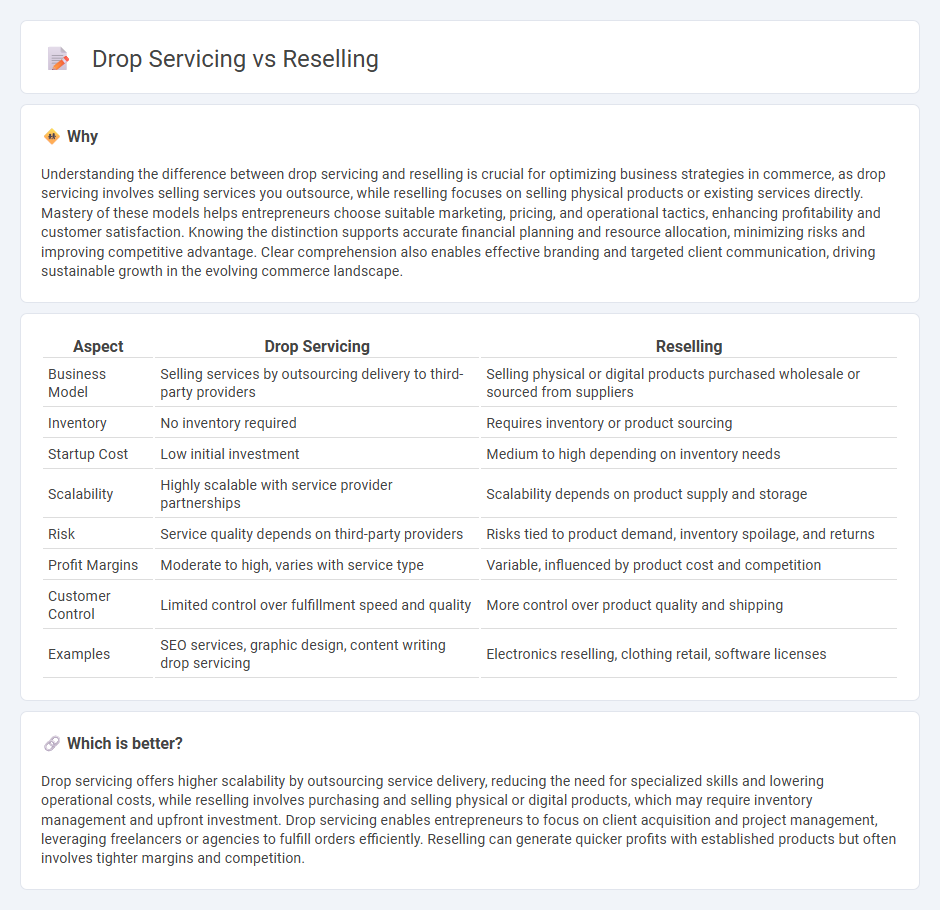
Drop servicing involves selling services performed by third-party providers, focusing on project management and client relations, while reselling centers on purchasing products wholesale and selling them at retail prices for profit. Drop servicing requires less upfront inventory investment compared to reselling but demands strong communication and coordination skills. Explore the distinctions further to determine which model suits your business goals.
Why it is important
Understanding the difference between drop servicing and reselling is crucial for optimizing business strategies in commerce, as drop servicing involves selling services you outsource, while reselling focuses on selling physical products or existing services directly. Mastery of these models helps entrepreneurs choose suitable marketing, pricing, and operational tactics, enhancing profitability and customer satisfaction. Knowing the distinction supports accurate financial planning and resource allocation, minimizing risks and improving competitive advantage. Clear comprehension also enables effective branding and targeted client communication, driving sustainable growth in the evolving commerce landscape.
Comparison Table
| Aspect | Drop Servicing | Reselling |
|---|---|---|
| Business Model | Selling services by outsourcing delivery to third-party providers | Selling physical or digital products purchased wholesale or sourced from suppliers |
| Inventory | No inventory required | Requires inventory or product sourcing |
| Startup Cost | Low initial investment | Medium to high depending on inventory needs |
| Scalability | Highly scalable with service provider partnerships | Scalability depends on product supply and storage |
| Risk | Service quality depends on third-party providers | Risks tied to product demand, inventory spoilage, and returns |
| Profit Margins | Moderate to high, varies with service type | Variable, influenced by product cost and competition |
| Customer Control | Limited control over fulfillment speed and quality | More control over product quality and shipping |
| Examples | SEO services, graphic design, content writing drop servicing | Electronics reselling, clothing retail, software licenses |
Which is better?
Drop servicing offers higher scalability by outsourcing service delivery, reducing the need for specialized skills and lowering operational costs, while reselling involves purchasing and selling physical or digital products, which may require inventory management and upfront investment. Drop servicing enables entrepreneurs to focus on client acquisition and project management, leveraging freelancers or agencies to fulfill orders efficiently. Reselling can generate quicker profits with established products but often involves tighter margins and competition.
Connection
Drop servicing and reselling share a core business model focused on outsourcing services or products to third parties while managing client relationships and sales. Both methods emphasize minimizing direct production or service delivery by acting as intermediaries, leveraging supplier networks to fulfill customer demands efficiently. This connection allows entrepreneurs to scale operations with reduced overhead and capital investment, optimizing profit margins in the commerce ecosystem.
Key Terms
Inventory
Reselling involves purchasing physical inventory or digital products to sell at a markup, requiring storage and management of stock, while drop servicing centers on selling services without holding any inventory, outsourcing service fulfillment directly to providers. Inventory management costs, risks of unsold products, and capital investment are significant factors distinguishing reselling from the virtually inventory-free model of drop servicing. Explore the detailed differences and strategic advantages of both business models to optimize your entrepreneurial approach.
Service Fulfillment
Service fulfillment in reselling involves purchasing products or services wholesale and then selling them at a markup, with the reseller often handling customer interactions but not the actual service delivery. Drop servicing, on the other hand, centers on selling services directly to clients while outsourcing the fulfillment to third-party experts, ensuring specialized quality without managing the service execution internally. Explore detailed strategies and advantages of both models to optimize your service fulfillment approach.
Profit Margin
Reselling often features lower profit margins due to purchasing inventory or services upfront, while drop servicing enables higher margins by outsourcing tasks without holding stock. Drop servicing leverages service arbitrage, minimizing risk and upfront costs compared to reselling physical products. Explore the key differences in profit structures to maximize your business growth.
Source and External Links
Reselling in Amazon Stores: Guidelines and Tips for Success - Reselling is an ecommerce model where you buy products from various sources and sell them online; key steps include researching product demand, sourcing items, listing them competitively, handling shipping, and managing inventory and customer service, with over 60% of Amazon sales coming from independent resellers who earn an average of $290,000 annually in the US.
Learn How To Become a Reseller And Start Selling Right Away - A reseller buys goods from manufacturers, liquidators, or retailers and sells them, often adding value through customer service and marketing, and can use a business permit to purchase items tax-free to resell at retail or wholesale.
How To Get Started as a Reseller: What and Where To Sell - Reselling involves buying products and selling them at a markup through platforms like eBay or Etsy, thriving especially in clothing resale, which is growing rapidly, making it an accessible business with low overhead and entry barriers.
 dowidth.com
dowidth.com